Your cart is currently empty!
Author: My IELTS Tutor
-

IELTS Listening – How to Solve Flow Chart?
A Flow Chart is a piece of information presented in a flow—data on a specific topic given in a process. The listening module of the IELTS exam covers a similar question type – Flow Chart Completion, which examines the candidate’s English language listening proficiency. IELTS Listening Flow Chart completion can be the easiest or the most challenging question type of Listening module affecting candidate scorecards. Is it easy to solve, or is it complicated? Let’s check.
IELTS Listening Flow Chart – Tips & Tricks to solve.
Flow Chart Completion usually comes in section 2 or section 3 of IELTS Listening, meaning the topic involves a moderate difficulty level because the sections are arranged in the order of complexity. As I mentioned earlier, all the information is presented in order and is a step-by-step process. Furthermore, sometimes you also receive options to respond in a particular manner; however, there can be more options than questions.
Let’s check out an example for more clarity.
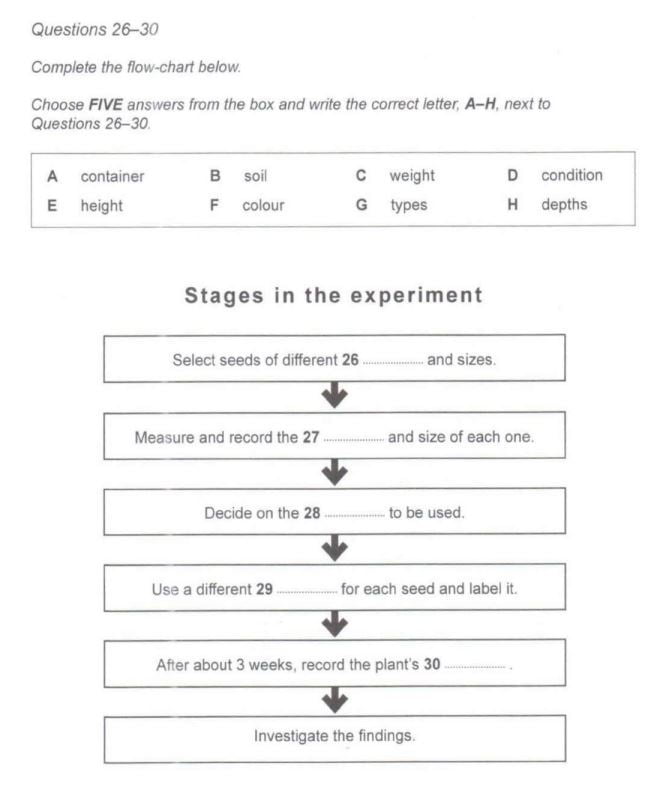
In this example of IELTS Listening Flow Chart Completion, have an eye on the process in the form of ‘stages of experiment’.
Tip 1 – Work before the audio starts.
The candidates must concentrate every minor second during the listening part of the exam. Don’t just wait for the audio to play to find the answers as you receive a question to respond to on your screen. Instead, skim and scan your questions prior.
Recognizing the subject beforehand makes you aware and confident of the information to score high bands effectively.
Read and acknowledge questions as well as options and listen to the audio for the answers. First, solve the sample passage of flow chart completion yourself.
Audio PlayerAnswers:
26 – G
27 – C
28 – H
29 – A
30 – ELet’s solve and unwind some secret strategies to answer the Flow Chart.
Question 26: Select seeds of different ___________ and sizes.
Answer – types
Transcript of the Audio:
[Note: Bold Words are terminologies or synonyms used in the question statement
and words in Italic represent transcriptions of the audio.]Anyway, shall we have a look at the procedure for our experiment? Will need to get
going with it quite soon.
Right, so the first thing we have to do is find our seeds. I think vegetable seeds would
be best, and obviously, they must not all be the same size. So how many sorts do we
need, about four different ones?
I think that would be enough. There’ll be quite a large number of seeds for each one.Tip 2 – Synonyms & Paraphrasing
In the audio, there is no mention of the word ‘types’ directly. However, they converse about sorts (types). Here, by using synonym and paraphrasing techniques, the examiner adjudicated to trick the candidates at the very first part of the conversation into getting them confused and thereby missing all the questions of this section. IELTS aspirants must realize what the examiner is looking for to not lose bands.
Question 27: Measure and record the _______ and size of each one.
Answer – weight
Then for each seed, we need to find out how much it weighs and also measure its dimensions and we need to keep a careful record of all that.
That’ll be quite time-consuming.Tip 3 – Don’t just wait for a similar word from the question to appear in the audio to start listening.
In addition to listening to the audio for the correct response, be attentive and not miss it, just waiting for a similar word to occur. For example, in the above question, terms such as measure & record arrived after the actual answer. The technique is called a distractor that the examiner uses to distract the candidates during their real IELTS exam.
Question 28: Decide on the _________ to be used.
Answer – depthsAnd we also need to decide how deep we’re going to plant the seeds right on the surface, a few millimeters down or several centimeters.
Tip 4 – Direct answers hidden in short sentences
While listening to the audio, have you ever come across a time where you are entirely concentrating yet lose to hear that required word in just a fraction of seconds? It happens because as the answers are direct, the examiner tends to hide them in short sentences for aspirants to miss hearing. Just like in this question, the exact use of the term ‘decide’ is done in the question as well as audio. ‘Decide how deep’, so the answer is depth.
Question 29: Use a different ________ for each seed and label it.
Answer – Container
Okay, so then we get planting. Do you think we can plant several seeds together in
the same plant pot?
No, I think we need a different one for each seed.
Hmm, right, and we’ll need to label them.Tip 5 – Usages of English Grammar
Before beginning with the audio, the IELTS listening exam allows applicants to look at the questions for a few seconds. Some utilize this as a break, rest as a strategy. Using time as a technique can make you confident here, but how?
While reviewing questions, candidates can respond accurately by eyeing English grammar and usage. For instance, in the above statement, the paper setter challenged to use something for each seed & label it. In question 29, only one option container is something one can label. Therefore, you have the correct answer without even listening to the audio.
However, this technique involves a lot of practice; it is effective.
Question 30: After about 3 weeks, record the plant’s _________.
We can use different colored labels then we wait for the seeds to germinate. I reckon that’ll be about three weeks, depending on what the weather’s like. Then we see if our plants have come up and write down how tall they’ve grown.
Tip 6 – Guess and Eliminate
The audio may last for 2-3 minutes, but it can feel completed in seconds during the actual listening exam because of high pressure. What if you miss hearing your answer? Use the guess method and eliminate the options depending on the mean idea of the audio you just heard.
Then all we have to do is look at our numbers and see if there’s any relation between them.
That’s right.
The last step – Investigate the Findings.Use the above tips and tricks and practice all the IELTS Listening Flow Chart Completion questions efficiently and productively. Let us know if this topic was complicated or easy for you guys, and Get in touch with us for any doubts in the comment section below.
-

IELTS Reading – Fill in the Blanks Tips Tricks & Strategies
Preparing for the IELTS exam, especially the IELTS Reading module, can be challenging for some aspirants. To not make you stand on the same side, today, in this article, I will cover IELTS Reading’s frequently asked question type; Fill in the Blanks, its Tips, Tricks & Strategies along with a solved practice sample to not miss out on any answer on blanks thereafter. After following the reading, you will be able to get an 8 or 9 band score in IELTS Reading.
IELTS Reading – Fill in the Blanks Tips, Tricks, and Strategies
In this question type of reading module, the candidates must fill the missing blank area of the statement depending on the information the reading passage highlights. Fill-ups are one of the complex questions because the examiner groups the passage & statements with synonyms, idiomatic words, and paraphrasing techniques to ensure the English language proficiency of IELTS aspirants.
Acknowledge the fact that similar words as in the reading passage are not given in your statements or options and therefore be attentive while solving IELTS Reading – Fill in the Blanks.
IELTS Reading – Fill in the Blanks practice sample
First, try to solve the following practice sample of IELTS Reading – Fill in the Blanks yourself.
Reading passage:
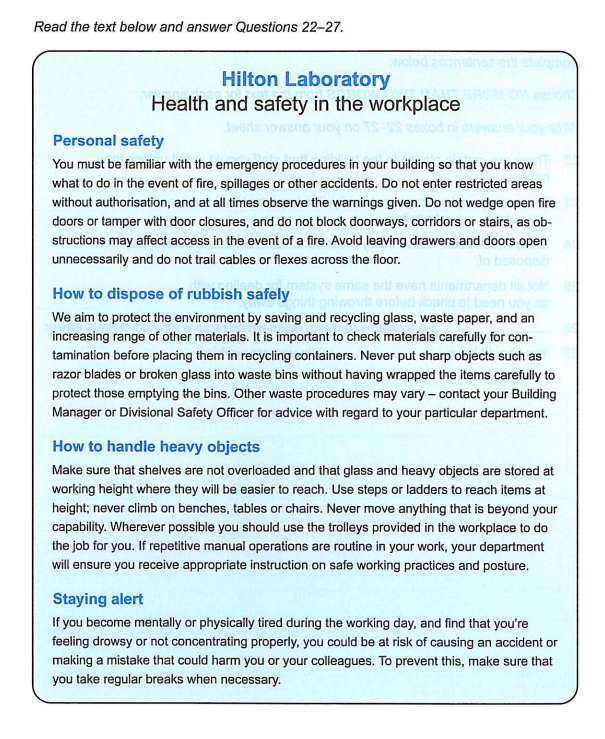
Instructions and Fill in the Blanks:
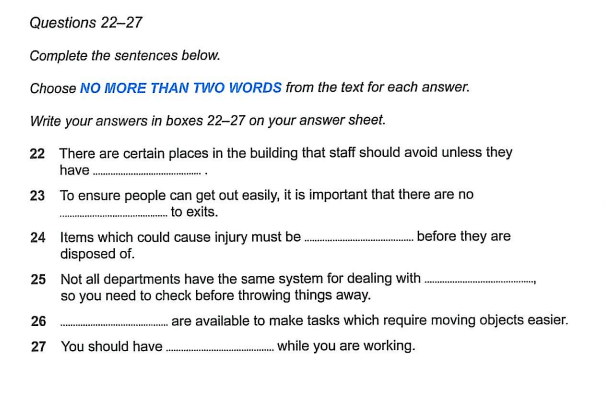
The above passage is on the health & safety measures undertaken by the staff of Hilton Laboratory, including directions of personal safety, how to dispose of rubbish safely, how to handle heavy objects, & staying alert while working. Additionally, the examiner instructs the candidates to not use more than two words in their response to the above fill-ups.
Fill in the Blanks Tips
Tip 1 – Mark the correct Paragraph.
The first and foremost step to follow, without missing any time, is to point out the correct paragraph to find an answer to a particular question. For example, question 24 is Items that could cause injury must be _______ before they are disposed of. In this statement, the word dispose of & injury indicates that the answer is in the second Paragraph, heading how to dispose of rubbish safely. Next, question 26 talks about moving objects easily, meaning those heavy because heavier things are hard to move from one place to another.
Note:
22 – 1st Paragraph
23 – 1st Paragraph
24 – 2nd Paragraph
25 – 2nd Paragraph
26 – 3rd Paragraph
27 – 4th ParagraphTip 2 – Maintain the order
This type of question has statements parallel to the reading passage meaning your answers will be in order so that if you are unable to answer any, you have a 70% chance of responding accurately by the method of guessing.
Tip 3 – Avoid Examples
The key to solving IELTS Reading Fill in the Blanks questions quickly as well as accurately is to avoid examples from the reading passage as your answers. Examples are added by the examiner to waste the time of candidates and confuse them with the right answer.
Fill in the Blanks Tricks
Tricks to solve the above sample quickly.
22) There are certain places in the building that staff should avoid unless they have_______.
Step 1 – The answer lies in.
1st paragraph.
Step 2 – Check for similar synonyms
Synonym – Places: areas
Avoid: restrict
Unless: withoutStep 3 – Underline the correct line
Do not enter restricted areas without authorization.
Step 4 – Find & Write your correct answer Authorization23) To ensure people can get out easily, it is important that there are no ____ to exist.
Step 1
1st paragraph
Step 2
Get out easily: affect accessStep 3
Do not wedge open fire doors or tamper with door closures & do not block
doorways, corridors, or stairs as obstructions may affect access in the event of a fire.
Step 4
The examiner has paraphrased the sentence adding examples of obstructions that can
affect the ease of access to people in the event of a fire or emergency.
Therefore, the correct answer is obstructions.24) Items that could cause injury must be _______ before they are disposed of.
Step 1
2nd paragraph.Step 2
Sharp objects are items that can cause injury Before they are disposed of means the examiner is looking for an answer to items that can cause injury to people after their disposal. Therefore, the accurate answer is a safety measure to undergo before disposal.
Step 3
Never put sharp objects such as razor blades or broken glass into waste bins without
having wrapped the items carefully to protect those emptying the bins.Step 4
The correct answer is Wrapped (carefully) / (carefully) Wrapped.
25) Not all departments have the same system for dealing with ___ so you need to check before throwing things away.Step 1
2nd Paragraph
Step 2
Same system: procedures
Check: contact
Step 3
Other waste procedures may vary – contact your Building or Divisional Safety Officer for advice with regard to your particular department.Step 4
Procedures are associated with waste so the correct answer is Waste
26) _______ are available to make tasks that require moving objects easily.
Step 1
3rd Paragraph
Step 2
Here the examiner has used both Synonyms and paraphrasing technique
Provided: available
Do the job for you: Make tasksStep 3
Never move anything that is beyond your capability. Whenever possible you should use the trolleys provided in the workspace to do the job for you.
Step 4
The correct answer is Trolleys
27) You should have _____ while you are working.
Solve this yourself with the above tricks.Answers:
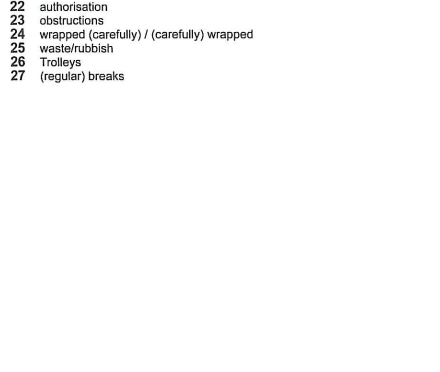
-

Academic Writing Task 1 sample 2
The chart and graph below give information about sales and share prices for Coca-Cola.
Write a report for a university lecturer describing the information shown below.
» You should write at least 150 words.
» You should spend about 20 minutes on this task.
Sample Answer
The pie chart and line graph reveal the global sales ratio of Coca-Cola in 2000 and its share price between 1996 and 2001.
Overall, It is apparently seen that America was the largest market for this brand. Also the share price of coca cola witnessed an increasing trend despite a minor drop and it was highest in 1998.
According to the pie chart, Coca-Cola sold 17.1 billion unit case in the year 2000 and more than 55% of this sale was made in North and Latin America collectively, latin america being higher compared to the former. Further, They sold around 20.5 billion unit case in Europe, which was their third largest sales ratio. Asian consumers has market of 16% unit case of Coca-Cola in this year and African and the Middle Eastern citizens together consumed 7% of the total sale in 2000.
The line graph shows that the share price of this brand was $36 in 1996 and it rapidly increased in the following years. Except in the middle of 1997, the price kept on going up until it reached its peak at around $80 per share in 1998. Hereafter, the price gradually declined and went below $50 in early 2000. Finally, the share price of Coca-Cola stood at around $60 during the mid-2000.
[carousel_slide id=’16536′]
-

IELTS Listening Master Program: Book a Free Training Session
IELTS Listening Master Program: In an IELTS Listening test, you would have to listen to a few audio recordings played by the examiner and answer the questions given below. These audio recordings will be in the form of monologues or conversations between two or more people.
What should you know about the IELTS Listening Test?
- Time allotted for the IELTS Listening section: The duration of the IELTS Listening test is 30 minutes. For a paper-based test, you will be given an extra 10 minutes to transfer your answers to an answer sheet. For a computer-delivered test, you will be given 2 minutes to recheck your answers.
- There are 4 sections in the IELTS Listening test and the difficulty level of the test increases for each section. Each section has 10 questions, and so there are 40 questions in total. Each question carries 1 mark.
- The examiner gives you time to look into the questions before you start listening to the recording that is played and in the end, you will have time to review the answers that you have written.
- The listening tests will be of the same type for both academic as well as general training categories.
- To answer these questions, you might need to have a good understanding of the monologues and conversations to interpret them and write the answers, as the words in the audio and questions might not be exactly the same.
- Be cautious about the word count limit and instructions. As some of these instructions would specify whether your answer should be a word, two words, a number, or numbers.
IELTS Listening Resources ( IELTS Master Program )
IELTS Listening Practice Test: Here you can practice IELTS Listening, find IELTS listening audios, question samples, and answers.
Note: IELTS Material Master Program – IELTS Listening is the same for Academic and General. So these practice tests hold good for IELTS Academic and General aspirants.
Test Overview
The first two parts of the test are about social requirements.
The latter two parts deal with situations that are more closely tied to educational or training settings.
All of the IELTS listening themes are of broad interest, regardless of what subjects you aim to study or what type of work you plan to pursue.
The recordings feature a variety of English accents and dialects, reflecting IELTS usage around the world.
How is the IELTS Listening module classified?
The classification of the listening module of the IELTS test is given below;
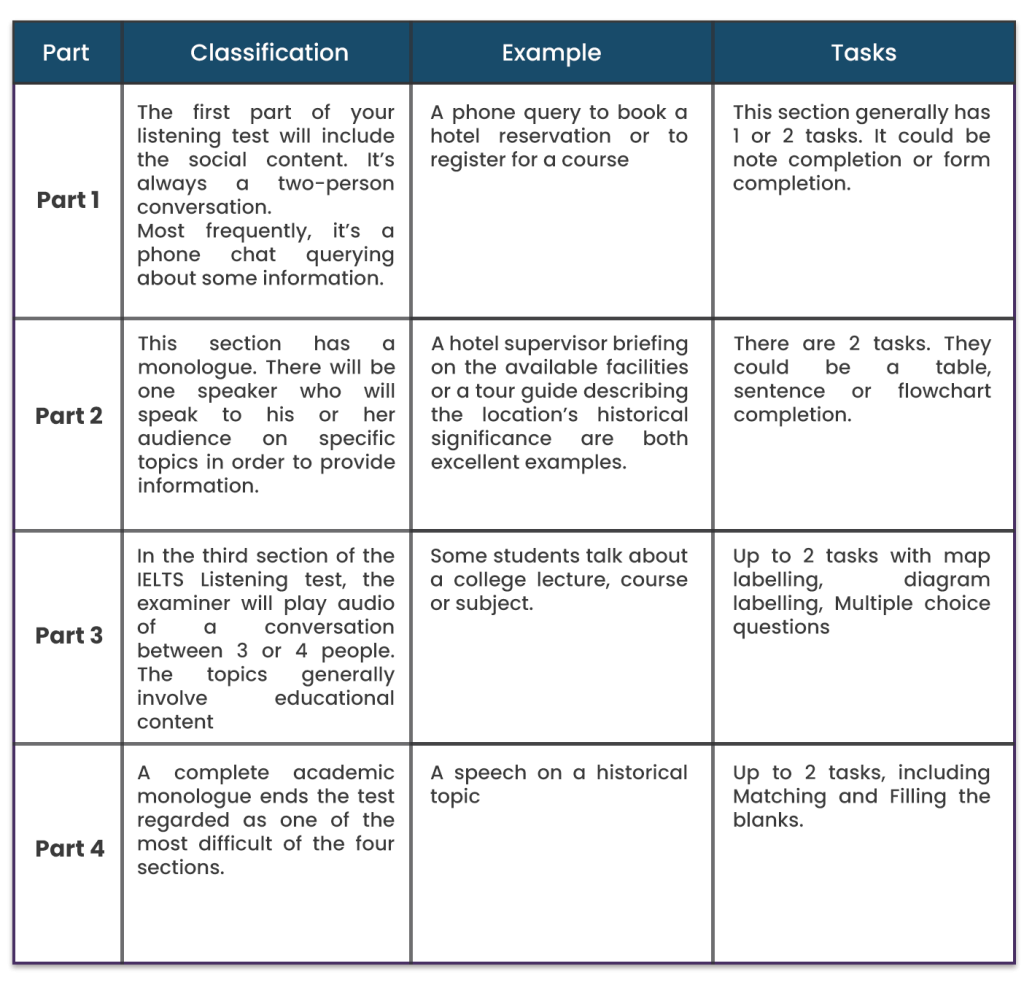
IELTS Listening Band Calculator
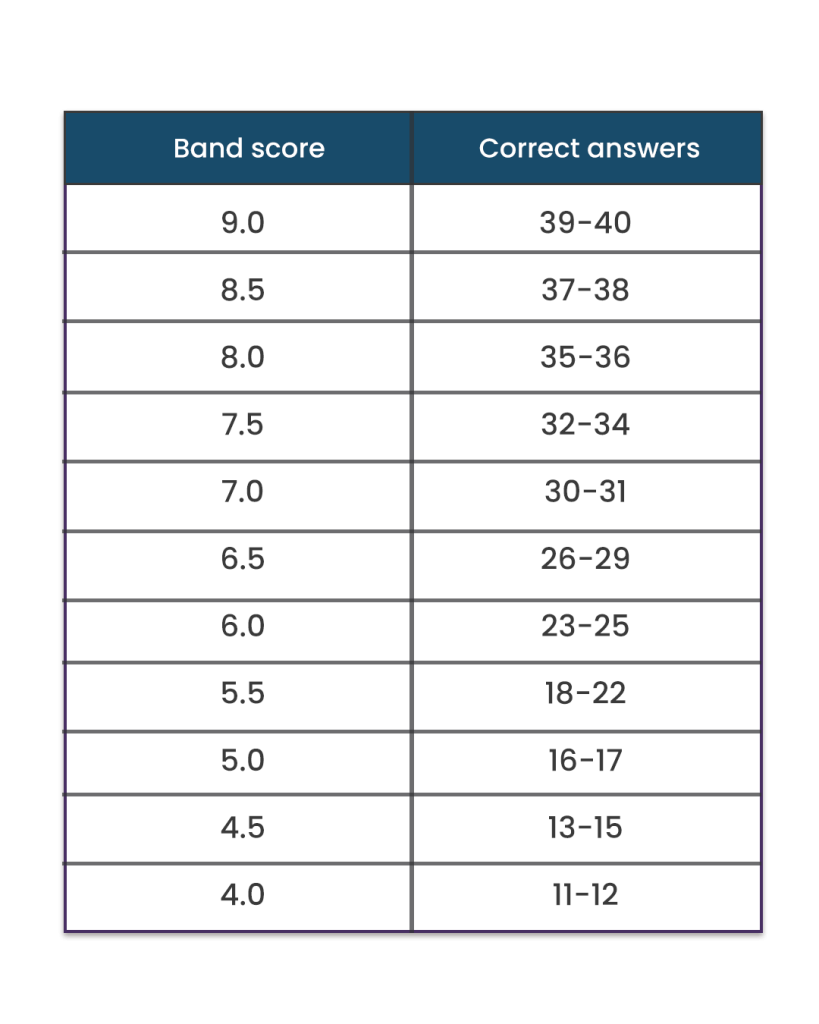
Now that you know how many marks you require as per the band desirability. The following is the IELTS exam question list, and you may encounter some of them in your actual IELTS test. Jot down the ones you find easiest to score as per your overall IELTS band requirement.
Types of Questions appearing in the IELTS Listening test
Although there are only four parts to the listening test, the types of questions differ for every exam. The students may encounter some of the following mentioned questions in their real IELTS test.
Form completion | Note completion | Summary completion
The students get questions like Note Completion or Form completion in the first part of the IELTS listening test. These questions are nothing but fill-ups. You will have missing gaps in a statement to fill up with usually exact words of the speaker from the audio. The difficulty level is the easiest compared to other parts of the test because of the order of difficulty criteria. The students must try their best to get all 10 questions of section 1 correct to grab easy bands with no effort.
The students might also get a conversation where the speaker corrects himself. For example, ‘It’s Loren gram, no Loren gran spelt with N.’ Do not take this negatively as it is distracting but instead take it positively that the speaker is helping you write the correct answer.
The best example of Form Completion is a quotation form of a company.
Besides form completion, note completion is also attributed to fill-ups, and in this task, there will be notes. The speaker will systematically give a piece of information. Moreover, if the speaker summarises the information on a topic stepwise, it is Summary Completion.
SAMPLE LISTENING- NOTE COMPLETION PRACTICE TEST 1
Instructions on How to Give This Practice Test:
1. Take a pencil and a copy.
2. Click on the audio link below.
3. While listening to the audio, answer questions 1-7 followed by the audio file.
(Reminder: In the real exam, you will write answers directly on the question paper and will get an extra 10 minutes to transfer answers to the answer sheet once the listening part is done.)
AUDIO –
Questions 1-7:
Complete the sentences below.
Write No More Than Two Words for each answer.
The Yavari: The Incredible Ship
Today
Where you can see the ship now: close to a 1. ………. At Puno Bay in Peru.
What visitors can do:
• Take a 2. ……….
• Sleep on the ship
History
Year when the ship was built: 3. ……….
Main material used in building the ship: 4. ……….
How it was transported to Peru by sea in small sections
How it was transported across Peru:
• By 5. ……….
• On horseback
Working Life
Raw material carried by the ship:
• Precious metals
• 6. ……….
The type of engine first fitted on the ship: 7. ……….
Answers: 1. (big) hotel 2. guided tour 3. 1862 4. iron 5. train 6. wool 7. steam (engine) Note: Words in brackets are optional – they are correct, but not necessary
Congratulations! You have successfully completed the above listening practice test. You are now familiar with the IELTS Listening Test question type – Form Completion. Now you can move on to get introduced to another type of IELTS Listening Test question which is termed as Note Completion.
IELTS Listening Sentence completion
Sentence Completion in the IELTS Listening part will provide you with a sentence to complete based on the audio you hear. The blanks might exist anywhere in the statement, but they are most commonly framed near the conclusion. Identifying what queries you are aiming for is by far the most crucial aspect. Moreover, practice more Sentence Completion question tasks of the IELTS Listening module and learn tips and tricks to crack them easily.
Commonly seen in the first section of the listening module, the examiner places a lot of distractors in this question task.
SAMPLE LISTENING- SENTENCE COMPLETION PRACTICE TEST 1
AUDIO-
Instructions on How to Give This Practice Test:
1. Take a pencil and a copy.
2. Click on the audio link below.
3. While listening to the audio, answer questions 21-25 followed by the audio file.
(Reminder: In the real exam, you will write answers directly on the question paper and will get an extra 10 minutes to transfer answers to the answer sheet once the listening part is done.)
Questions 21-25:
Complete the sentences below.
Write NO MORE THAN THREE WORDS AND/OR A NUMBER for each answer.
21. Ministers and officials put the ………. of the agriculture business first.
22. Hormones make cattle ………., thus making meat production more profitable.
23. The use of hormones was banned over ………. ago in Europe.
24. The USA and Canada asked the WTO to declare the ban ………. .
25. A Danish study that hormones are over ………. more dangerous than was previously thought.
ANSWERS- Answers 21-25: 21. profits 22. grow faster 23. 20/ twenty years 24. illegal 25. 200
SAMPLE LISTENING- TABLE COMPLETION PRACTICE TEST 1
AUDIO –
Questions 11-17:
Complete the table below.
Write NO MORE THAN TWO WORDS AND/ OR A NUMBER for each answer.
CFCs (chlorofluorocarbons) and the Ozone Layer
11. ………. Electron Capture Detector invented by James Lovelock 1973 Lovelock one self-funded 12. ………. to Arctic/ Antarctic Lovelock’s conclusion: CFCs 13. ………. 1974 Rowland and Molina publish world’s first 14. ………. on connection 1975 State of Oregon introduces world’s first ban of CFCs 1978 CFCs in 15. ………. banned in US and some parts of Europe 16. ………. Hole in ozone layer above Antarctica first detected 1987 Signing of Montreal Protocol 1989 EU ban production of all CFCs by end of 17. ………. Answers –
Answers 11-17: 11. 1957 12. research trip 13. not harmful 14. scientific paper 15. spray cans/ spray – cans 16. mid 1980s/ mid – 1980s 17. (the) century
Flow-chart completion
Yet another critical task of the IELTS Listening module is Flow chart completion. This task depicts the steps of a process. There will be a beginning and a finish to the procedure, with various steps in between.
A flow chart in IELTS Listening may include almost anything that can be broken down into stages, such as a lecture or essay outline, an application procedure, training course stages, or an explanation of the manufacturing process.
Having moderate difficulty, this question task usually appears in section 2.
SAMPLE LISTENING- FLOW CHART PRACTICE TEST 1
Audio –IELTS Listening – Flow Chart Completion – IELTS SUPPORT
Questions 1-5:
Complete the flow-chart below.
Write No More Than Two Words for each answer.
Five Stages in the Process of Designing a Building
Answers
Answers 1-5: 1. client’s/ clients’ needs 2. materials 3. plans 4. contractors 5. clarifying
(Reminder: In the real exam, you will write answers directly on the question paper and will get extra 10 minutes to transfer answers to the answer sheet once the listening part is done.)
IELTS Listening Multiple choice questions ( MCQs )
The examiner can frame two types of Multiple Choice Questions. One is to choose one correct answer and another to choose multiple answers. IELTS Listening Multiple Choice Questions are difficult and therefore usually appear in section 3 or 4 of the test. The task is difficult because there are long sentences to read and choose a correct response in very little time. In addition to that, sometimes, if any question candidate misses out while hearing the audio, it is very likely to miss all questions and lose 5 or more marks.
Further, if the examiner asks to choose multiple answers with lengthy statements, it becomes harder to answer and gain bands.
SAMPLE LISTENING- MULTIPLE CHOICE QUESTIONS PRACTICE TEST 1
AUDIO –
(Reminder: In the real exam, you will write answers directly on the question paper and will get an extra 10 minutes to transfer answers to the answer sheet once the listening part is done.)
Questions 1-6:
Circle the correct letters A-C.
1. Emiliano is hoping to rent a house for
A. 8 months
B. 6 months
C. 7 months
D. 12 months
2. As proof of identity, Emiliano gives his
A. passport and student card
B. passport and bank card
C. student card and bank card
D. student card and driving licence
3. Emiliano can be contacted
A. on his mobile
B. by leaving a message at his homestay
C. by telephoning his school
D. by e-mail
4. Emiliano is looking for a house which is less than
A. half an hour away by bus
B. one hour away by bus
C. one hour away by bus or train
D. half an hour away by bus or train
5. He can find the weekly cost of the house by
A. asking the estate agent
B. looking at the house list
C. looking at the sign outside the house
D. asking the owner of the house
6. When he moves out, Emiliano will get back
A. his deposit and agent fee
B. the equivalent of one week’s rent
C. his deposit
D. the equivalent of one week’s rent and his deposit
Answers 1-6: 1. B 2. A 3. A 4. D 5. B 6. C
Map labelling | Diagram labelling
The last task of the listening module is map labelling or diagram labelling. Students might get puzzled by the recording and, therefore, may lose bands in this task. For example, the speaker explains some routes to various areas or floors in a college hall. Another example most commonly appears in the IELTS exam is of routing places of a complex such as restaurants, clubs, libraries, and likewise.
Diagram labelling, on the contrary, lets students label any picture based on the audio recording. For instance, two speakers discuss a bicycle and define various elements of it, such as tyres made of a particular material, and the students will have a similar option to label with tyres.
SAMPLE LISTENING- MAP QUESTIONS PRACTICE TEST 1
AUDIO –
(Reminder: In the real exam, you will write answers directly on the question paper and will get extra 10 minutes to transfer answers to the answer sheet once the listening part is done.)
Questions 11-15:
Label the map/ plan below.
Choose FIVE answers from the box and write the correct letters A-I next to the questions 11-15.
ANSWERS
Answers 11-15: 11. H 12. G 13. D 14. B 15. F
Both of these tasks of IELTS Listening are easy if students pursue good listening skills.
In conclusion, the Listening module of the IELTS exam is easy. The students can get 8+ or perfect band nine if they understand how to respond to them smartly.
[carousel_slide id=’16536′]
-

Academic Writing Task 1 Sample 3
You should spend about 20 minutes on this task.
Academic Writing Task : The graph shows the revenues City department revenues from 1959-1966. Summarise the information by selecting and reporting the main features and make comparisons where relevant.
Write at least 150 words
The bar graph illustrates data regarding the city’s income from two different sources (Departmental, the State which includes vehicle tax) for the years 1959 to 1966. Units are measured in tens of millions.Overall, the city received much of its income from departmental revenues throughout the entire time period. Moreover, departmental revenues were either double or more than revenue from the state during this period as well. Another interesting feature is that both sources of income rose steadily throughout the six-year period.
Money collected from the various city departments began at roughly 35 million at the start of the period but dipped the next year to approximately 33 million. From there, it rose until 1962 where it flattened (around 37 million) through 1963. After that year, revenue increased sharply over the next to years to peak at its highest level in 1965 (50 million).
Also Read : IELTS Listening Tips: Sentence Completion or Fill in the Blanks! Learn with 1 Solve Sample.Money paid to the city by the state followed a different trend. In 1966, it was at approximately 12 million and rose until 1961 (around 16 million). Following that year, it dropped slightly in 1962 (nearly 13 million). Then state revenue rose over the course of the next two years, peaking in 1964 at approximately 20 million. From that point, it decreased during 1965 and reached a level similar to that of 1963 (around 15 million)
Practice More and More for Academic Writing Task.
-

Academic Writing Task 1 Sample 4
Academic Writing Task: You should spend about 20 minutes on this task. The maps display the changes made over time in the Village of Stokeford.
Summarise the information by selecting and reporting the main features and make comparisons where relevant.Chart
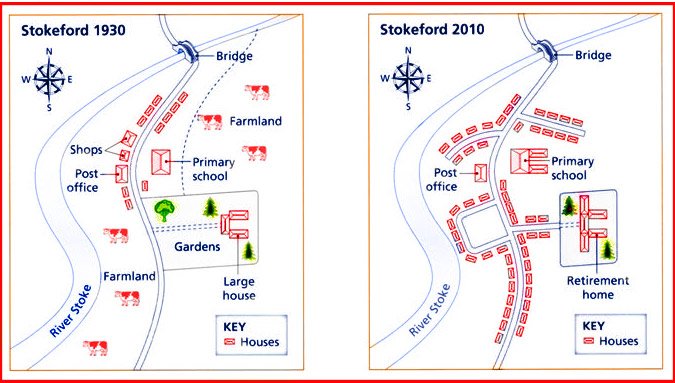
Write at least 150 words (Academic Writing Task)
The two maps given illustrate how the village of Stockford has changed over a period of 80 years (from 1930 to 2010).
Overall, Stockford underwent significant changes during the 80 year period. The two most significant changes were the change in land use from agriculture to residential. As a result, all land for farming was changed mostly to residential housing. Moreover, the only facilities that remain still remain are the post office and the school.Back in 1930, there was only one road which ran North-South through the village with a side road leading to gardens and a large house to the East.
North of the Gardens and adjacent to them was a primary school. To the north of the school were 7 houses along the main road (4 on the east side, 3 on the west). Just south of the houses on the west side of the road were two shops that were followed by the post office.
South of the post office was two houses and opposite these, one house lay adjacent to the gardens in the north. Surrounding this area was farmland. A little south another road branched west of the main road, and it too is lined with houses.
This all changed by 2010. As mentioned, all farmland was eliminated. Just south of the bridge, a road branched off the main road, and houses were built along with it.
North of this road are three houses and just south of the east road is one house South of the post office on the opposite side of the main road are several houses that and a road branches eas where the entrance to the gardens was. This road is lined with 4 houses and ends at a retirement home.
South of the post office, another road branches west and circles back to the main road. This street is also lined with houses and the street returns to the main road just south of the lane that leads to the retirement home. From this point, both sides of the main road are lined with houses.
Read More :
Academic Writing Task 1 Sample
-

Things to Keep in Mind Before Taking the IELTS Listening Test.
IELTS Listening Test is the first module of the test, students get during the exam. In this section, the examiner plays a few audio recordings. These recordings are either in the form of monologues or conversations, and the students have to answer questions accurately based on the audio to score high bands in the IELTS Listening test.
If you wish to go abroad and want to score 8777 on the IELTS test then Listening can do half your job.
Things to keep in mind before taking the IELTS Listening test.
- There are two types of IELTS Listening test : Academic and General. However, the listening module is the same in both types of exam categories.
- The test is for 2 hours and 45 minutes, but, IELTS Listening is of 30 minutes in total.
- If you are going for a paper-based test, there will be 10 minutes to transfer your answers from rough (if needed) to the actual answer sheet.
- For a computer-based test, students will have 2 minutes to check their answers.
- The module includes four sections, each with 10 questions and the level of difficulty in order to sections.
- Every question is of 1 mark with no negative marking. Therefore 40 questions for 40 marks.
- As this section has audio recording, the students will have time to review questions before the examiner plays audio. After the audio is finished, candidates will again have some time to check their answers.
- The examiner defines a few instructions for each section of the IELTS Listening module.
Why are Instructions important for the IELTS exam?
There are four elements of the IELTS test namely, Listening, Reading, Writing, and Speaking. To prepare well for the IELTS exam, students must understand the examiner’s instructions as they limit the word count of their answers.
These instructions come with questions and look like, ‘Write NO MORE THAN THREE WORDS AND/OR A NUMBER for each answer.‘ The statement guides the candidate to answer the questions of that particular IELTS Listening section with a word limit of 3 words and no more than that. The students for the above instructions can include a number along with 3 words if the answer demands.
Similarly, there are instructions such as Write no more than two words or/and a number, One word only, One word or/and a number. To avoid inputting the wrong answer, be mindful of the word count limit and instructions during your exam.
After the students are thorough with what these instructions mean, they must clearly understand how the IELTS Listening module is classified.
How is the IELTS Listening module classified?
The classification of the listening module of the IELTS test is given below;
PARTS CLASSIFICATION EXAMPLE TASKS PART 1 The first part of your listening test will include the social content. It’s always a two-person conversation. Most frequently, it’s a phone chat querying about some information. A phone query to book a hotel reservation or to register for a course. This section generally has 1 or 2 tasks. It could be note completion or form completion. PART 2 This section has a monologue. There will be one speaker who will speak to his or her audience on specific topics in order to provide information. A hotel supervisor briefing on the available facilities or a tour guide describing the location’s historical significance is both excellent examples. There are 2 tasks. They could be a table, sentence or flowchart completion. PART 3 In the third section of the IELTS Listening test, the examiner will play audio of a conversation between 3 or 4 people. The topics generally involve educational content. Some students talk about a college lecture, course or subject. Up to 2 tasks with map labelling, diagram labelling, Multiple choice questions PART 4 A complete academic monologue ends the test regarded as one of the most difficult of the four sections. A speech on a historical topic. Up to 2 tasks, including Matching and Filling the blanks. 6 ways to boost your IELTS Listening band score from 6 to 8 bands
After having a brief of how the questions appear in the IELTS exam’s actual listening test and how they are classified in different parts, students must be aware of ways to tackle them. This module of the test includes the audio recordings played only once. You will not hear them twice; therefore, I will reveal a few secret tips to boost your scores of IELTS Listening and get a perfect band 9.
Time Management
During the listening exam, my students frequently comment that they don’t have enough time to look at the questions or write responses. In the listening exam, it is critical to use your time carefully. Because all students have the same amount of time, students who manage their time well will receive higher grades than students who do not. Take note of how much time is given to you in the instructions: “Now have some time to look at questions 20 to 24” OR “Now you have half a minute to check your answers.”
When it comes to time management, understanding questions quickly and knowing what to listen for is essential. Manage your time wisely with good listening skills as above all training will help you get better at these things—best of luck with your upcoming IELTS exam.
Be attentive
However, the IELTS Listening difficulty rises as the students proceed with questions, but the examiner also allows cracking answers using indicators and plugins. The examiner uses certain words like however, but, finally, that helps anticipate the speaker’s idea. Try to acquire a sense of what’s going on. You’ll get a short introduction before each part, which is essential to note. It appears for example: ‘Now, you’ll hear a chat between…’ or ‘Now, you’ll hear a lecture on…’ Be aware that this information is not mentioned on the question paper.
Please note who is speaking, why they are talking, and where they are located. Such parameters will make the rest of the tape much more accessible for students to comprehend.
Avoid Distractors
Being attentive and avoiding distractors works hand in hand because the examiner induces several types of distractors in the IELTS Listening Test. Distractors are most commonly seen in dialogues, where one speaker says something and the other speaker corrects him or her. In order words, you’ll hear two different versions of the identical piece of information. One is correct, and the other is erroneous, and if you don’t pay attention, it’s obvious to write the incorrect one. Another example of the examiner distracting students is by setting traps using similar keywords the wrong way in the audio. These distractors may cause you to make dumb errors on the test, so be prepared to deal with them on test day. Avoid them to improve your IELTS Listening scores.
Have Patience
The examiner plays the audio once; therefore, make sure to understand the idea, listen to the correct word in their singular or plural forms, have eyes peeled on questions, and most importantly, write the correct spellings. Doing all such tasks at once can make students impatient. They also tend to lose on listening to some part of the recording and hence miss on questions. You can also be on their part, so be patient whether you miss one question as there is a long way to go. You have the rest of the questions to respond precisely to boost your listening test bands.
Instructions
As mentioned earlier, Instructions are essential to answer the correct way. If you do not follow the examiner’s prescribed guidelines, your answer will not be given attention while marking.
Correct Spellings
Writing the answers to your IELTS listening module with correct spellings is as essential as getting them right. For instance, the speaker in the audio meant ‘principal’, but the answer is incorrect when you write ‘principle’. You heard the examiner right yet misinterpreted the meaning. Some most commonly repeated words appear in the IELTS exam; practice them to avoid errors such as incorrect spellings.
The students can point out these mistakes while practicing for the IELTS exam to improve listening scores. However, be aware of the types of questions appearing in the IELTS Listening section for a perfect band 9.
Wait a minute, Do you need 8+ bands in IELTS Listening?
If yes, How many questions must be correct?
IELTS Listening Band Calculator
Each Question carries 1 mark Marks obtained Bands 39-40 9 37-38 8.5 35-36 8 32-34 7.5 30-31 7 26-29 6.5 23-25 6 18-22 5.5 16-17 5 13-15 4.5 11-12 4 Now that you know how many marks you require as per the band desirability. The following is the IELTS exam question list, and you may encounter some of them in your actual IELTS test. Jot down the ones you find easiest to score as per your overall IELTS band requirement.
Types of Questions appearing in the IELTS Listening test
Although there are only four parts to the listening test, the types of questions differ for every exam. The students may encounter some of the following mentioned questions in their real IELTS test.
Form completion | Note completion | Summary completion
The students get questions like Note Completion or Form completion in the first part of the IELTS listening test. These questions are nothing but fill-ups. You will have missing gaps in a statement to fill up with usually exact words of the speaker from the audio. The difficulty level is the easiest compared to other parts of the test because of the order of difficulty criteria. The students must try their best to get all 10 questions of section 1 correct to grab easy bands with no effort.
The students might also get a conversation where the speaker corrects himself. For example, ‘It’s Loren gram, no Loren gran spelt with N.’ Do not take this negatively as it is distracting but instead take it positively that the speaker is helping you write the correct answer.
The best example of Form Completion is a quotation form of a company.
Besides form completion, note completion is also attributed to fill-ups, and in this task, there will be notes. The speaker will systematically give a piece of information. Moreover, if the speaker summarizes the information on a topic stepwise, it is Summary Completion.
IELTS Listening Sentence completion
Sentence Completion in the IELTS Listening Test part will provide you with a sentence to complete based on the audio you hear. The blanks might exist anywhere in the statement, but they are most commonly framed near the conclusion. Identifying what queries you are aiming for is by far the most crucial aspect. Moreover, practice more Sentence Completion question tasks of the IELTS Listening Test module and learn tips and tricks to crack them easily.
Commonly seen in the first section of the listening module, the examiner places a lot of distractors in this question task.
Table completion
In addition to the above question tasks, the examiner also frames Table Completion in the IELTS Listening test.
Table completion is a prevalent type of question to show up in any part of the listening exam. Spend time crafting the headings and predicting the table’s lacking material. Also, pay attention to the maximum number of words that can be used in the replies to improve the score. In this task, the examiner asks to fill the missing gaps in the table, and these gaps generally include the main points discussed by the speaker during a conversation or a monologue.
A most important tip to solve table completion is taking notes of important points during the recording because, in the actual test, the recording is played only once.
Flow-chart completion
Yet another critical question task of the IELTS Listening Test module is Flow chart completion. This task depicts the steps of a process. There will be a beginning and a finish to the procedure, with various steps in between.
A flow chart in IELTS Listening may include almost anything that can be broken down into stages, such as a lecture or essay outline, an application procedure, training course stages, or an explanation of the manufacturing process.
Having moderate difficulty, this question task usually appears in section 2.
Matchings
To assess a candidate’s English language skills, the IELTS Listening Test section includes a range of question formats, and one such is Matching, which tests an aspirant’s detailed English comprehension.
IELTS Listening Matching is a task where you must choose one correct option from a numbered list. The recording gives a detailed discussion on a topic. For example, two people talk about a certain issue, agree, disagree, or exchange their perspectives on one or more aspects of the topic. The options you choose from are always a condensed version of a more in-depth discussion and to correctly reply to IELTS Listening Matchings, the candidate must first comprehend who and what the statement is about.
IELTS Listening Multiple choice questions ( MCQs )
The examiner can frame two types of Multiple Choice Questions. One is to choose one correct answer and another choose multiple answers. IELTS Listening Multiple Choice Questions are difficult and therefore usually appear in section 3 or 4 of the test. The task is difficult because there are long sentences to read and choose a correct response in very little time. In addition to that, sometimes, if any question candidate misses out on while hearing the audio, it is very likely to miss all questions and lose 5 or more marks.
Further, if the examiner asks to choose multiple answers with lengthy statements, it becomes harder to answer and gain bands.
Map labeling | Diagram labeling
The last task of the listening module is map labeling or diagram labeling. Students might get puzzled by the recording and, therefore, may lose bands in this task. For example, the speaker explains some routes to various areas or floors in a college hall. Another example most commonly appears in the IELTS exam is of routing places of a complex such as restaurants, clubs, libraries, and likewise.
Diagram labeling, on the contrary, lets students label any picture based on the audio recording. For instance, two speakers discuss a bicycle and define various elements of it, such as tyres made of a particular material, and the students will have a similar option to label with tyres.
Both of these tasks of IELTS Listening Test are easy if students pursue good listening skills.
In conclusion, the Listening module of the IELTS exam is easy. The students can get 8+ or perfect band nine if they understand how to respond to them smartly.
-

A Complete IELTS Test Guide
Why IELTS Test?
IELTS Test Guide : The IELTS exam is easy to crack, but many students consider it tough, making it the most difficult English proficiency test. The test measures a candidate’s English language skills based on four communicative areas: reading, writing, speaking, and listening.
IELTS test is essential for candidates seeking employment or further education in nations where English is the native language like the United Kingdom, the United States of America, New Zealand, Australia, Ireland, etc. The aspirants looking to work in any country with English as a native language enroll in IELTS General, whereas students seeking to pursue higher education give IELTS Academic. The test is available in two ways: one is computer-based (CBT), and the other is paper-based (PBT).
The best way to prepare for the IELTS exam is to practice & practice as many sample questions as possible. There is a lot of free practice material for the IELTS test available on the internet. Practice it to crack your desired IELTS bands.
But the question is: How much practice?
How much time does it take to crack the IELTS exam?
Cracking the IELTS test, I believe, is not difficult. However, this varies from person to person. One can be good at writing while others excel at listening, so it depends on candidates how much time they want to crack the IELTS exam.
If you are proficient in English and wish to achieve a high score band on the IELTS, two months of preparation is more than enough. It all relies on your talent level, ranging from average to excellent.
You can take a sample exam with different portions (Reading, Writing, Listening, and Speaking) and look at the result to get an idea of how much time you’ll need to prepare for IELTS. If you get a score of 21-27, you’ll be able to get 6+ bands in less than a month of preparation.
Moreover, it would be best to devote specific time to your preparation. Your performance on practice tests determines the appropriate number of hours. If you believe that 6 hours a day is sufficient to achieve an 8 band score, those should be your ideal hours. Further, after you’ve figured out your learning style, create a plan that allows you to be most productive. You don’t have to sit for 7–8 hours straight; divide your time and work as needed.
IELTS Test Registration procedure
Candidates can register for IELTS either online or in person at their local IDP office. Test-takers may select from 80 IELTS test centres across India, making it easy to choose one that is convenient for them. There are no explicit IELTS qualifying requirements. It is open to anybody, regardless of gender, age, ethnicity, religion, or nationality. IELTS is not available to anybody under the age of 16. The following are the steps for both online and offline IELTS registration:
IELTS ONLINE REGISTRATION
- Firstly, Locate an IELTS test center near you. There are 1,600 test locations across the world. You can also register online from the official website of IELTS.
- Next, Register your information and book the test by paying online. While registration, submit valid documents as you will need this application on the test day.
- After the application has been processed, the testing center will confirm the test date and time. It will be sent via email or regular mail.
IELTS OFFLINE REGISTRATION
IELTS aspirants can download the IELTS exam registration form from the official website. Manually choose the test date and complete the form’s other prerequisites. After the registration form is filled, the candidate must then pay either by DD (made payable to “IDP EDUCATION INDIA PRIVATE LIMITED, Payable at New Delhi”) or cash (at ICICI bank with a payment slip). The candidate must also offer a Blue Dart courier operable address on the registration form.
NOTE: The candidates will have the Listening, Reading, and Writing sections of the exam on the same day. However, speaking can either be on the same day or within a week before or after the other sections. IELTS authorities will provide the information about the same to you at your registered email address.
IELTS Test Registration cost
Test Type Cost (INR) Computer-delivered IELTS for UKVI 15,100 Computer-delivered IELTS 14,700 IELTS Life Skills (A1 and B1) 13,940 IELTS for UK Visas and Immigration 15,100 Pen and paper-based IELTS 14,700 source: https://www.ieltsidpindia.com/
The approximate cost for the IELTS exam is Rs15000 only.
Candidates can pay their IELTS test fees either online through net banking Visa or Mastercard credit or debit card, DD, or in person at an ICICI bank.
However, you must check for cancellation and rescheduling costs before paying the fee. A 25% administrative charge will be levied from the refund if the applicant cancels the exam in the duration of 5 weeks or more before the scheduled test date.
There will be no reimbursement if the cancellation is made less than 5 weeks from the test date. In addition to that, the test will be considered canceled if the candidate is not present for the exam. In case, by any reason you miss present in the exam, you can reschedule it. The charges for rescheduling the IELTS test is Rs3000 with a protocol of candidates rescheduling the date within three months of their scheduled date.
IELTS TEST FORMAT – IELTS Test Guide
IELTS test is of two types Academic and General. There are four sections of the test. Listening and Speaking sections of the exam remain the same for all but Reading and Writing have different questions. The complete test format and a variety of questions the examiner asks are given below. The examiner frames a combination of questions in the test.
TEST SECTIONS AND QUESTIONS LISTENING READING IELTS ACADEMIC WRITING IELTS GENERAL WRITING SPEAKING 1 Form Completion True/ False/ Not Given Questions Essay on the topic given in the form of bar chart, pie, or image Letter Introduction 2 Note Completion Yes/ No/ Not Given Questions Essay Essay Cue Card 3 Sentence Completion Multiple Choice Questions Discussion 4 Table Completion Multiple Choice, Multiple Answers Questions 5 Flow Chart Completion Match the Headings Questions 6 Matchings Matching Information or Features Questions 7 MCQ’s Answer Short Questions 8 Map Labelling Matching Sentence Endings 9 Diagram Labelling Sentence Completion or Fill in the Blanks 10 Choose from the List Questions 11 Note | Summary | Flow chart Completion On IELTS Test day
- IELTS test day can create panic and make candidates nervous, affecting their performance. Be prepared with the right documents and reach the test center an hour before the scheduled exam time. You might not be allowed to enter the examination hall if you reach there late.
- Once you reach inside the hall, stay calm and follow the instructions mentioned in IELTS application form.
- No breaks are there between the three sections other than speaking. Therefore, you will have to sit for 2 hours and 40 minutes straight in the test room, so eat properly before your test . The supervisors only permit a transparent water bottle inside the test room.
- Once your examination begins, read and follow the instructions and start with the questions accordingly. Do not make silly errors and lose points.
- Moreover, have an eye on the time limit as well as IELTS Test Guide .
IELTS Results
For PBT, the candidates receive test results within 13 days of the test while for the Computer-based IELTS test candidates receive results three to five days following the test. The results are made available through an email by the officials with a link to view the scorecard. The candidates must download this scorecard and get the same print as the results will be available for 28 days to view online.
If you are looking to check your results and have given IELTS through IDP, please follow the link of IELTS Test Guide .
How is your score calculated?
IELTS is scored in bands from 0-9, where 0 is assigned when candidates do not attempt any question, while 9 is given to an expert user who uses English appropriately, accurately, and fluently. Firstly, the examiner scores individual to a section, i.e., Listening, Reading, Writing, and Speaking, and then the average is calculated to produce an IELTS overall band score .
The IELTS writing section has two tasks, and task 2 has more weightage than task 1. The weightage of task 2 is 66%, and that of task 1 is 33%.
IELTS exam scores validity
The scores are valid for two years from the time of the result.
IELTS Resitting.
The candidates who fail to achieve their desired IELTS scores can resit and retake the test whenever they are ready. However, before registering for IELTS Test Guide , keep in mind that your bands are unlikely to improve without a dedicated effort to improve your scores.
